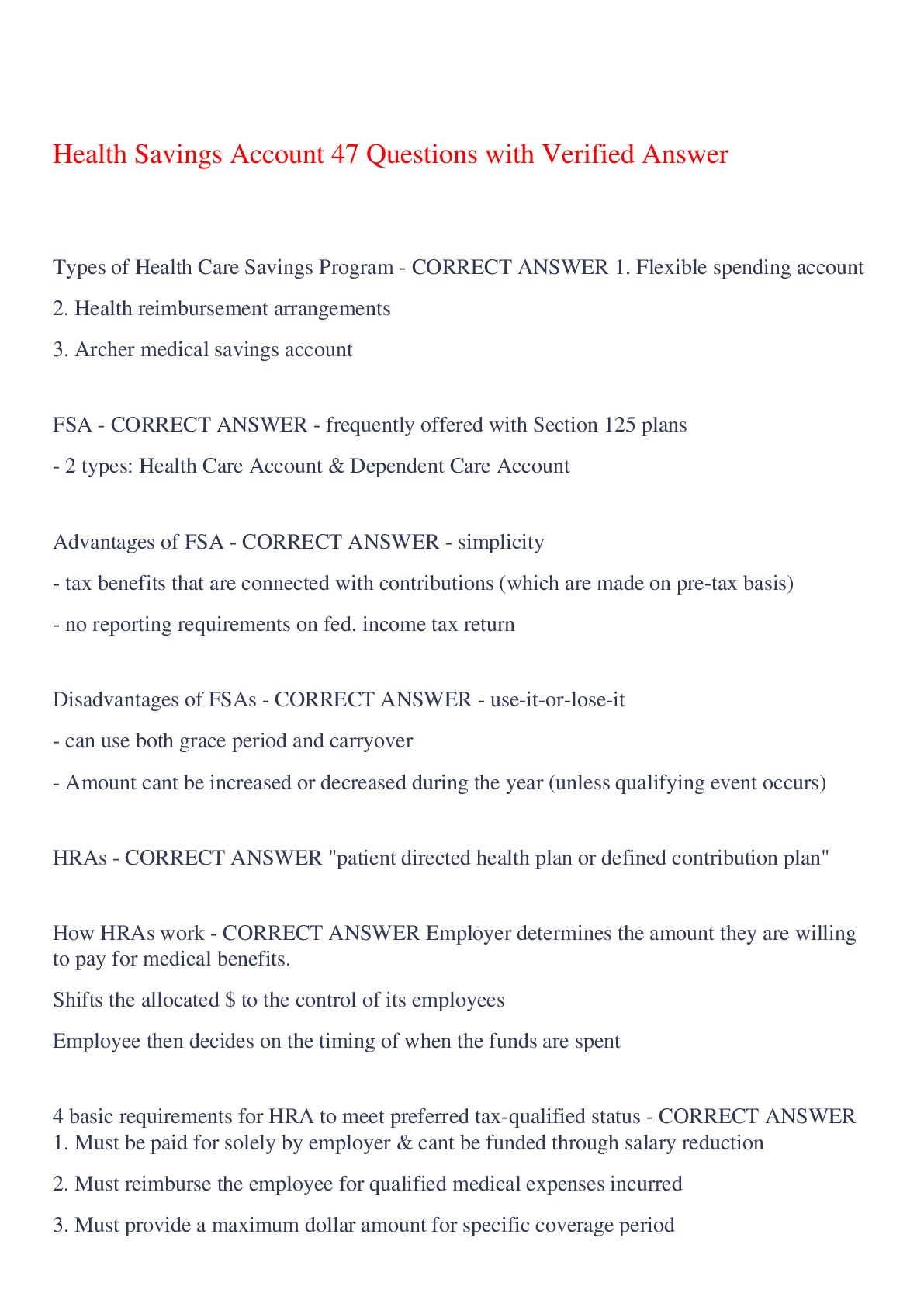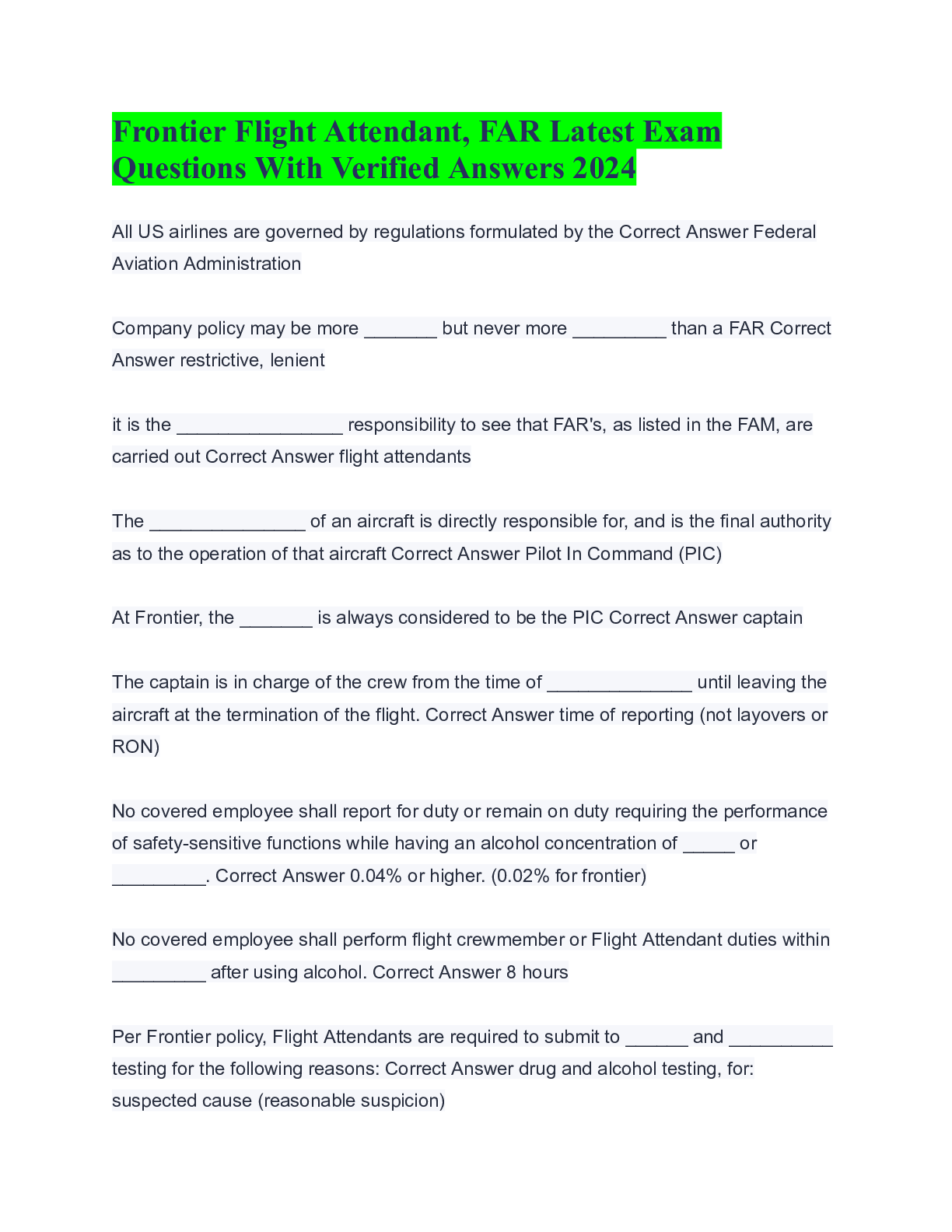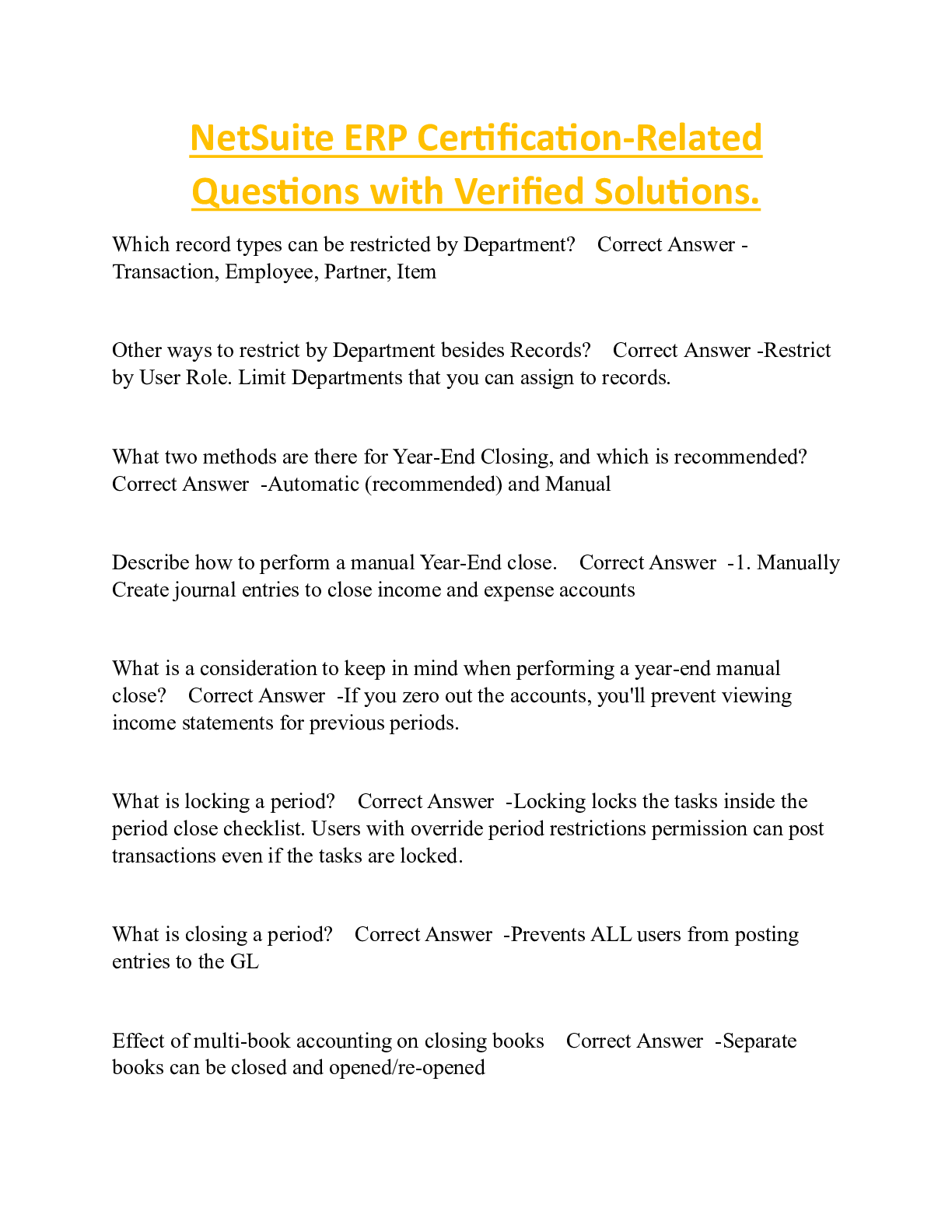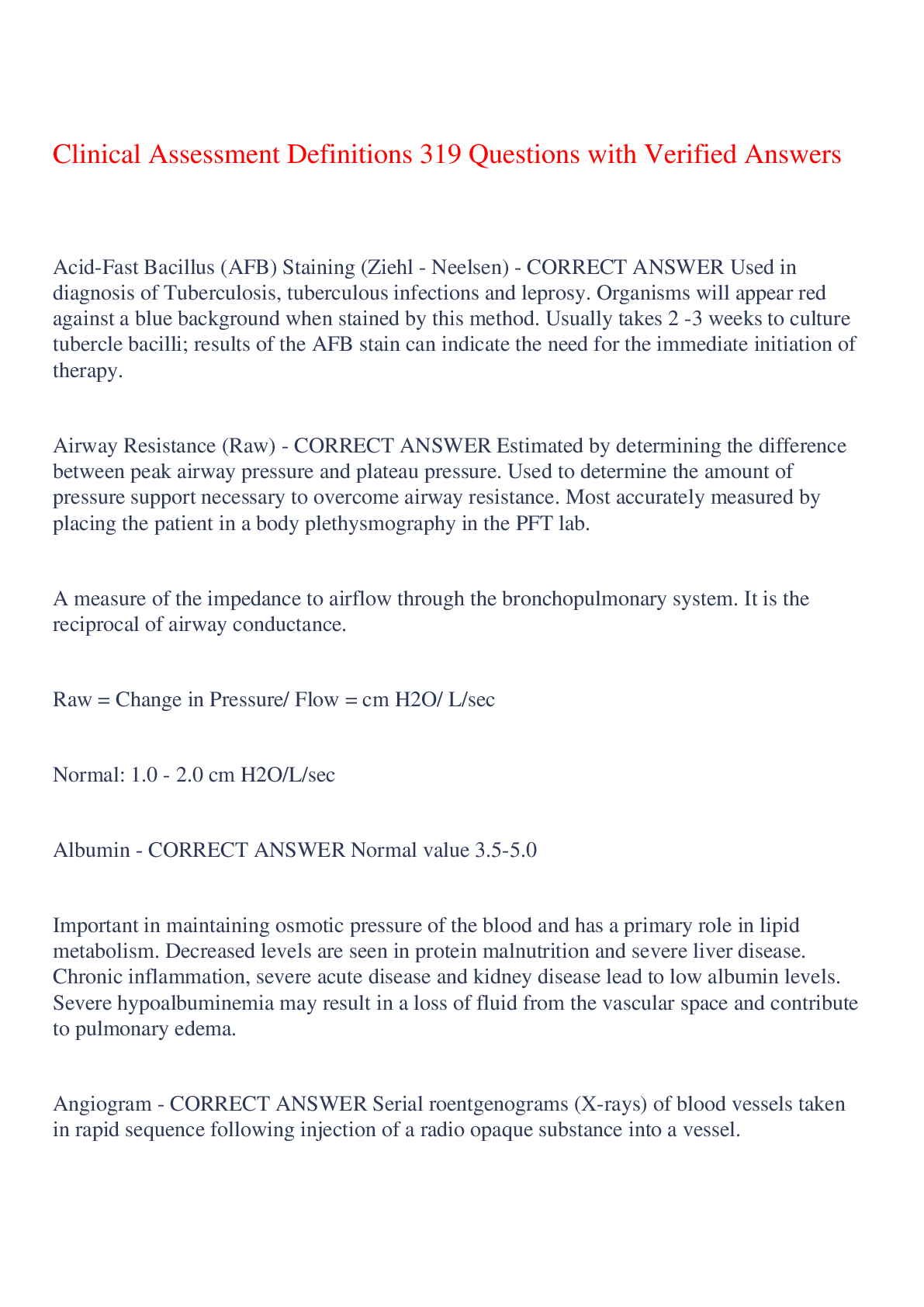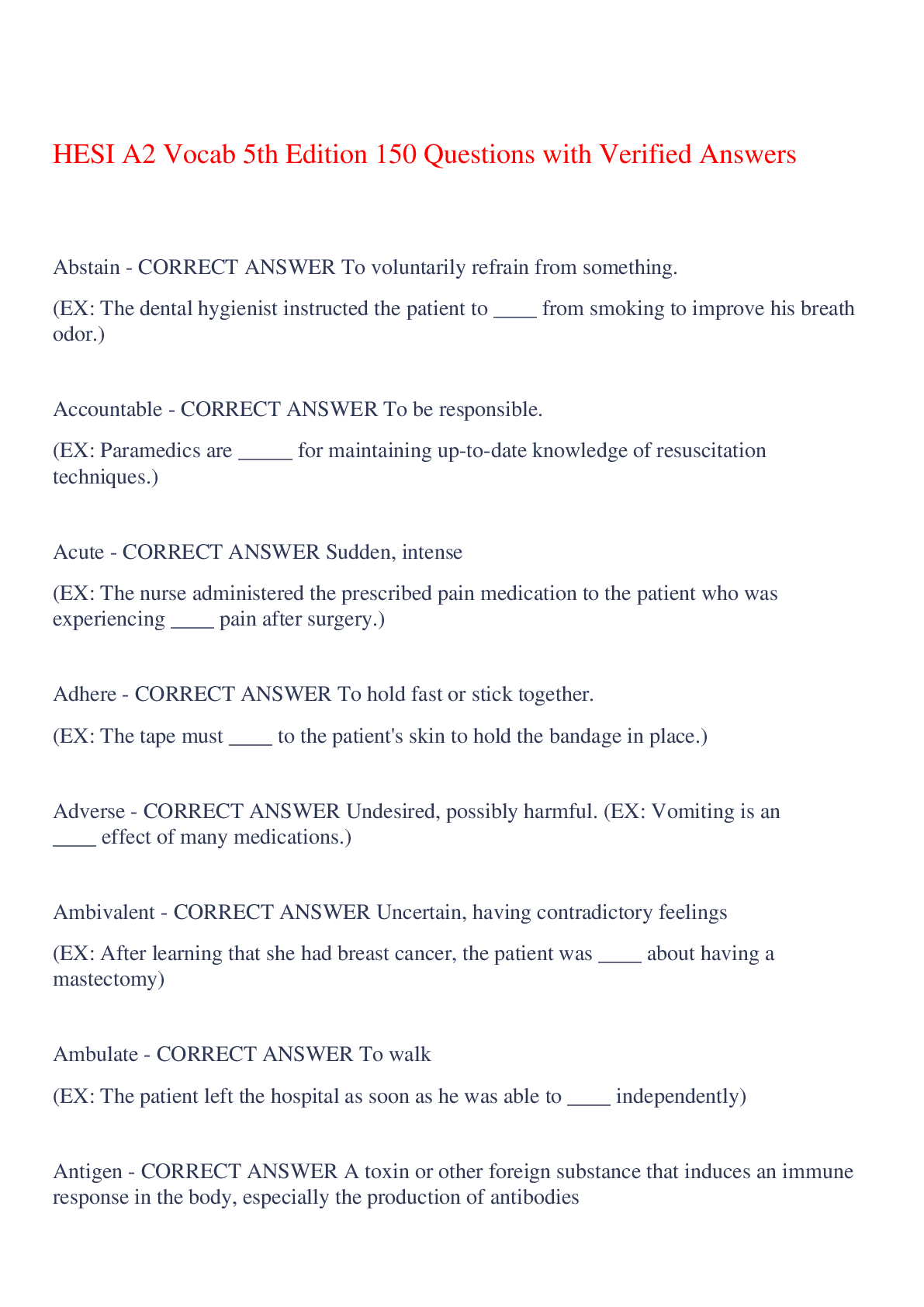HESI A2 ENTRANCE > EXAM > HESI A2 Entrance Exam 150 Questions with Verified Answers,100% CORRECT (All)
HESI A2 Entrance Exam 150 Questions with Verified Answers,100% CORRECT
Document Content and Description Below
HESI A2 Entrance Exam 150 Questions with Verified Answers Abstain - CORRECT ANSWER To voluntarily refrain from something. (The dental hygeienist instructed the patient to _____ from smoking to im... prove his breath odor.) Accountable - CORRECT ANSWER To be responsible. (Paramedics are _____ for maintaining up-to-date knowledge of resuscitation techniques.) Acute - CORRECT ANSWER Sudden, intense. (The nurse administered the prescribed pain medication to the patient who was experiencing _____ pain after surgery.) Adhere - CORRECT ANSWER To hold fast or stick together. (The tape must _____ to the patient's skin to hold the bandage in place.) Adverse - CORRECT ANSWER Undesired, possibly harmful. (Vomiting is an _____ effect of many medications.) Aegis - CORRECT ANSWER Control, protection (Unit staffing decisions are under the _____ of the nurse manager) Ambibalent - CORRECT ANSWER Uncertain, having contradictory feelings (After learning that she had breast cancer, the patient was _____ about having a mastectomy.) Apply - CORRECT ANSWER To place, put on, or spread something. (The nurse will _____ a medication to the wound before covering the wound with a bandage.) Assent - CORRECT ANSWER To give consent; to agree (The attention was asked to _____ to the surgery by signing the informed consent document.) Audible - CORRECT ANSWER Able to be heard (The respiratory therapist noted the patient's _____ wheezing as a symptom of the patient's asthma.) Bacteria - CORRECT ANSWER Single-called, microscopic organisms (The physician ordered a laboratory test to confirm that the patient's illness was caused by _____ rather than a virus.) Bilateral - CORRECT ANSWER Present on two sides. (The unlicensed assistive personnel reported to the nurse that the patient had _____ weakness int he legs when walking.) Cardiac - CORRECT ANSWER Of or relating to the heart (Smoking increases the risk of _____disease.) Cavity - CORRECT ANSWER An opening or an empty area. (The nurse inspected the patient's oral _____ for lesions.) Cease - CORRECT ANSWER Come to an end or bring to an end (Because the patient's breathing had _____, the paramedic began resuscitation measures.) Chronology - CORRECT ANSWER Order of events as they occurred; timeline. (The police interviewed witnesses and first responders to determine the _____ of the accident.) Compensatory - CORRECT ANSWER Offsetting or making up for something. (When the patient's blood pressure decreased, the paramedic noted that the heart rate increased, which the paramedic recognized as a _____ action.) Concave - CORRECT ANSWER Rounded inward (The dietician noticed that the patient was very thin and that the patient's abdomen appeared _____.) Concise - CORRECT ANSWER Brief, to the point. (When teaching a patient, the nurse tried to be _____ so that the instructions would be easy to remember.) Consistency - CORRECT ANSWER Degree of viscosity; how thick or thin a fluid is in relation to how it flows. (The respiratory therapist noticed that the mucus the patient was coughing was of a thin, watery _____.) Constrict - CORRECT ANSWER To draw together or become smaller. (The nurse knows that the small blood vessels of the skin will _____ when ice is applied to the skin.) Contingent - CORRECT ANSWER Dependent (The hygienist told the patient that a healthy mouth is _____ on careful daily brushing and flossing.) Contraindication - CORRECT ANSWER A reason something is not advisable or should not be done. (The patient's excessive bleeding was a _____ for discharge front eh hospital.) Convulsive - CORRECT ANSWER Having or causing convulsions, i.e., violent shaking of the body. (Epilepsy is a _____ disorder) Cursory - CORRECT ANSWER Quick, perfunctory, not thorough. (During triage, the paramedic gave each accident victim a _____ examination.) Defecate - CORRECT ANSWER Expel feces. (The unlicensed assistive personnel helped the patient to the toilet when the patient needed to _____.) Deficit - CORRECT ANSWER A deficiency or lack of something. (The therapist explained that the patient will experience a fluid _____ if the patient continues to perspire heavily during exercise without drinking enough fluids.) Depress - CORRECT ANSWER Press downward (The nurse will _____ the patient's skin to see if any swelling is present.) Depth - CORRECT ANSWER Downward measurement from a surface (The physician measures the _____ of a wound by inserting a cotton swab into the wound.) Deteriorating - CORRECT ANSWER Worsening (The dental hygienist explains that the condition of the patient's gums is deteriorating and treatment by the dentist is needed right away.) Device - CORRECT ANSWER Tool or piece of equipment (A thermometer is a _____ used to measure the patient's body temperature) Diagnosis - CORRECT ANSWER Identification of an injury or disease. (The patient received a _____ of pancreatitis.) Dilate - CORRECT ANSWER To enlarge or expand (When shining a light in the patient's eyes, the nurse looks to see if both pupils _____ in response to the light.) Dilute - CORRECT ANSWER To make a liquid less concentrated. (The pharmacy technician suggests that the patient use fruit juice to _____ a foul-tasting drug so that the medication will be easier to swallow.) Discrete - CORRECT ANSWER Distinct, separate (The paramedic observed several _____ bruise marks on the patient's body.) Distal - CORRECT ANSWER Distant; away from the center (such as of the body) (The paramedic suspected that the patient had a dislocated knee and knew it was important to check a _____ pulse in the ankle.) Distended - CORRECT ANSWER Enlarged or expanded from pressure. (When a blood vessel is _____, the laboratory technician can easily insert a needle to obtain a blood sample.) Dysfunction - CORRECT ANSWER Impaired or abnormal functioning. (Family _____ may increase when a member experiences an acute physical illness.) Empathy - CORRECT ANSWER Ability to share what others are feeling; understanding the feelings of another. (After being diagnosed with cancer, the physician felt more _____ toward patients with cancer.) Equilibrium - CORRECT ANSWER Balance (The nurse suspected that an ear infection was the cause of the patient's lack of _____.) Etiology - CORRECT ANSWER The origin or cause of a disease or condition (The nurse interviewed the patient to determine the _____ of the patient's food poisoning.) Exacerbate - CORRECT ANSWER To make worse or more severe. (The physical therapist recognized that too much exercise would _____ the patient's breathing difficulties.) Expand - CORRECT ANSWER To increase in size or amount (The unlicensed assistive personnel turned the patient frequently so that the skin sore would not _____ any further.) Exposure - CORRECT ANSWER To come in contact (The nurse taught the parents of a new born to avoid _____ to people with severe infections.) Extension - CORRECT ANSWER Lengthening; unbending a joint. (The physical therapist helped the patient perform _____ and flexion exercises.) External - CORRECT ANSWER Located outside the body (The unlicensed assistive personnel measured the amount of blood in the _____ drain after the patient's surgery.) Fatal - CORRECT ANSWER Resulting in death (The emergency epically technicians arrived too late to save any lives at the scene of a _____ car accident.) Fatigue - CORRECT ANSWER Extreme tiredness, exhaustion. (The dietician explained to the patient that eating more iron-rich foods may help reduce feelings of _____.) Flexion - CORRECT ANSWER Bending a joint (Arthritis can make _____ of the fingers difficult.) Flushed - CORRECT ANSWER Reddened or ruddy appearance (The therapist observed that the patient's face was _____ after the patient completed the exercises.) Gastrointestinal - CORRECT ANSWER Of or relating to the stomach and the intestines. (The patient was diagnosed with a _____ disease. Hematologic - CORRECT ANSWER Of or relating to blood. (Pregnancy can put a woman at risk for anemia, which is a _____ disorder.) Hydration - CORRECT ANSWER Maintenance of body fluid balance. (The medical assistant explains that adequate _____ helps keep skin soft and supple) Hygiene - CORRECT ANSWER Measures contributing to cleanliness and good health. (The dental assistant teaches patients about good _____ practices to maintain strong teeth.) Impaired - CORRECT ANSWER Diminished or lacking some usual quality or level. (The paramedic stated that the patient's _____ speech was obvious in the way she slurred her words.) Impending - CORRECT ANSWER Occurring in the near future, about to happen. (The nurse manager increased the emergency room staffing in anticipation of accidents being caused by the _____ snowstorm.) Impervious - CORRECT ANSWER Impenetrable, not allowing anything to pass through. (Standard precautions require that use of _____ gloves when bodily fluids are handled.) Imply - CORRECT ANSWER To suggest without explicitly stating. (The look on the administrator's face _____ that she was happy about the results of the inspection.) Incidence - CORRECT ANSWER Occurrence (In recent years there has been an increased _____ of infections that do not respond to antibiotics.) Infection - CORRECT ANSWER Contamination or invasion of body tissue by pathogenic organisms. (The doctor prescribed antibiotics for the patient with a bacterial _____.) Infer - CORRECT ANSWER To conclude or deduce. (When the patient started crying while receiving and injection, the nurse _____ that the patient was in pain.) Inflamed - CORRECT ANSWER Reddened, swollen, warm, and often tender (The nurse observed that the skin around the patient's wound was _____.) Ingest - CORRECT ANSWER To swallow for digestion. (The paramedic may contact the poison control center when providing emergency care for a child who has _____ cleaning fluid.) Initiate - CORRECT ANSWER To begin or put into practice. (The nurse decided to _____ safety measures to prevent injury because the patient was very weak.) Insidious - CORRECT ANSWER So gradual as to not become apparent for a long time. (The physician explained that the cancer probably started years ago but had not been detected because its spread was _____.) Intact - CORRECT ANSWER In place, unharmed (The nurse observed that the patient's bandage was _____.) Internal - CORRECT ANSWER Located within the body. (The paramedic reported that the patient was unconscious because of _____ bleeding.) Invasive - CORRECT ANSWER Inserting or entering into a body part. (The laboratory technician is careful when obtaining blood samples because this _____ procedure may cause problems such as infection or bruising.) Kinetic - CORRECT ANSWER Of or related to movement (_____ energy from the battery of the medical assistant's tablet caused the device to feel warm to the touch.) Labile - CORRECT ANSWER Changing rapidly and often. (Because the child's temperature was _____, the nurse instructed the unlicensed assistive personnel to check the temperature frequently) Laceration - CORRECT ANSWER Cut; tear (After the accident, the paramedic examined the patient's _____.) Latent - CORRECT ANSWER Present but not active or visible. (The _____ infection produced symptoms only when the patient's condition was weakened from another illness.) Lateral - CORRECT ANSWER On the side. (The physical therapist recommended exercises to help increase the strength of the patient's _____ muscles.) Lethargic - CORRECT ANSWER Difficult to arouse. (The unlicensed assistive personnel observed that on the morning after a patient received a sleeping pill, the patient was too _____ to eat breakfast.) Lysis - CORRECT ANSWER Gradual decline of disease symptoms Manifestation - CORRECT ANSWER An indication or sign of a condition. (The dietician looked for _____ of poor nutrition, such as excessive weight loss and poor skin condition.) Musculoskeletal - CORRECT ANSWER Of or relating to muscle and skeleton (As a result of overtraining, the athlete suffered a _____ injury.) Neurologic - CORRECT ANSWER Of or relating to the nervous system. (The nurse checked the _____ status of the patient who was brought to the emergency room after a motorcycle accident.) Neurovascular - CORRECT ANSWER Of or relating to the nervous system and blood vessels. (Strokes and aneurysms are _____ disorders.) Nutrient - CORRECT ANSWER Substance or ingredient that provides nourishment. (The dietician explains that fruits and vegetables contain _____ that reduce the risk of some cancers.) Occluded - CORRECT ANSWER Closed or obstructed. (Because the patient's foot was cold and blue, the nurse reported that the patient's circulation to the foot was _____.) Ongoing - CORRECT ANSWER Continuous. (The nurse instructed the patient that the treatment would be _____ throughout the patient's entire hospital stay.) Oral - CORRECT ANSWER Given through or affecting the mouth. (The patient's instructions stated "no _____ fluids for 24 hours following surgery." Otic - CORRECT ANSWER Of the ear (The physician prescribed an _____ medication to treat the patient's ear infection.) Parameter - CORRECT ANSWER A characteristic or constant factor, limit. (The dietician explained that the number of calories needed for energy is one of the important _____ of a healthy diet.) Patent - CORRECT ANSWER Open (The nurse checked to see whether the intravenous needle was _____ before giving the patient a medication.) Pathogenic - CORRECT ANSWER Causing or able to cause disease. (Viruses and bacteria are _____ organisms.) Pathology - CORRECT ANSWER Processes, causes, and effects of a disease; abnormality. (The doctor called to request the _____ report for her patient.) Posterior - CORRECT ANSWER Located behind; in the back. ( the dentist examined the _____ surface of the tooth for a cavity.) Potent - CORRECT ANSWER Producing a strong effect (The _____ medication immediately relieved the patient's pain.) Potential - CORRECT ANSWER Capable of occurring or likely to occur. (Because the patient was very weak, the therapist felt the patient had a high _____ for falling.) Precaution - CORRECT ANSWER Preventive measure (The laboratory technician wore gloves as a _____ against blood contamination.) Precipitous - CORRECT ANSWER Rapid, uncontrolled (The paramedic assisted the pregnant woman during a _____ delivery in her home.) Predispose - CORRECT ANSWER To make more susceptible or more likely to occur. (The dietician explains that high dietary fat intake _____ some people to heart disease.) Preexisting - CORRECT ANSWER Already present (The nurse notified the physician that the patient has a _____ condition that might lead to complications during the emergency surgery.) Primary - CORRECT ANSWER First or most significant (The patient's _____ concern was when he could return to work after the operation.) Priority - CORRECT ANSWER Of great importance. (The laboratory technician was gentle when inserting the needle because it is a heigh _____ to ensure that the patient does not experience excessive pain and discomfort during the procedure.) Prognosis - CORRECT ANSWER The anticipated or expected course or outcome. (The physician explained that, with treatment, the patient's _____ was for a long and healthy life.) Rationale - CORRECT ANSWER The underlying reason. (To make sure that the patient will follow the diet instructions, the medical assistant explains the _____ for the low-salt diet) Recur - CORRECT ANSWER To occur again (To make sure that a tooth cavity does not _____, the dental hygienist instructs the patient to use toothpaste with fluoride regularly.) Renal - CORRECT ANSWER Of or relating to the kidneys. (The nurse closely monitored the oral intake and urinary output of the patient with acute _____ failure.) Respiration - CORRECT ANSWER Inhalation and exhalation of air (Exercise increases the rate and depth of the individual's _____.) Restrict - CORRECT ANSWER To limit (The unlicensed assistive personnel removed the water pitcher from the room to assist the attention in following instructions to _____ the intake of fluids.) Retain - CORRECT ANSWER To hold or keep (The nurse administered a medication to prevent the patient from _____ excess body fluid, which might cause swelling.) Serene - CORRECT ANSWER Calm, tranquil. (The massage therapist played _____ music during the massage session to help the patient relax.) Status - CORRECT ANSWER Condition (The paramedic recognized that the patient's _____ was unstable, which necessitated immediate transport to the nearest medical center.) Sublingual - CORRECT ANSWER Under the tongue (The patient was prescribed a _____ medication for chest pain.) Supplement - CORRECT ANSWER To take in addition to or to complete. (The dietician instructed the patients to _____ their diets with calcium tablets to help build strong bones.) Suppress - CORRECT ANSWER To stop or subdue. (When the child's temperature decreased, the nurse checked to see if any medications had been given that would have _____ the fever.) Symmetric (symmetrical) - CORRECT ANSWER Being equal or the same in size, shape, and relative position. (The paramedic observed that the movement of both sides of the patient's chest was _____ after the accident.) Symptom - CORRECT ANSWER An indication of a problem (The nurse recognized that the patient's weakness was a _____ of bleeding after surgery.) Syndrome - CORRECT ANSWER Group of symptoms that, when occurring together, reflect a specific disease or disorder. (After reviewing the patient's symptoms, which included pain and tingling in the hand and fingers, the physician made a diagnosis of carpal tunnel _____.) Therapeutic - CORRECT ANSWER Of or relating to the treatment of a disease or a disorder. (_____ diets may include calorie and salt restrictions.) Toxic - CORRECT ANSWER Causing harm, poisonous. (The pediatrician recommended that the parents of a toddler keep all _____ substances out of the toddler's reach.) Transdermal - CORRECT ANSWER Crossing through the skin (The physician prescribed a _____ nicotine patch for a patient participating in the smoking cessation program.) Transmission - CORRECT ANSWER Transfer, such as of a disease, from one person to another. (Nurses should wash their hands to prevent the _____ of infections.) Trauma - CORRECT ANSWER Injury, wound (The accident victim had severe facial _____.) Triage - CORRECT ANSWER Process used to determine the priority of treatment for patients according to the severity of a patient's condition and the likelihood of benefit from the treatment. (When the paramedics arrived at the scene of the accident, they had to _____ the patients.) Ubiquitous - CORRECT ANSWER Being or seeming to be everywhere at once. (The patient noticed the _____ "no smoking" signs in the clinic.) Urinate - CORRECT ANSWER Excrete or expel urine. (The patient was instructed to _____ into the container so the nurse could send a urine sample to the laboratory.) Vascular - CORRECT ANSWER Of or relating to blood vessels. (The patient underwent _____ surgery for repair of an abdominal aortic aneurysm.) Verbal - CORRECT ANSWER Spoken, using words. (The paramedic called in a _____ report on the patient's condition to the emergency room nurse while transporting the patient to the hospital.) Virulent - CORRECT ANSWER Extremely harmful and severe. (The _____ infection required and aggressive treatment regimen.) Virus - CORRECT ANSWER Microscopic infectious agent capable of replicating only in living cells, usually causing infectious disease. (A person with a cold who goes shopping can transmit the _____ to others.) Vital - CORRECT ANSWER Essential (The paramedic knows that it is _____ to learn what the of Oisin was taken when caring for a poisoning victim.) Volume - CORRECT ANSWER Amount of space occupied by a fluid (The nurse recorded the _____ of cough syrup administered to the patient.) Digit - CORRECT ANSWER Any number 1 through 9 and 0 Place Value - CORRECT ANSWER The value of the position of a digit in a number Product - CORRECT ANSWER The answer to a multiplication problem Dividend - CORRECT ANSWER The number being divided Divisor - CORRECT ANSWER The number by which the dividend is divided Quotient - CORRECT ANSWER The answer to a division problem Remainder - CORRECT ANSWER The portion of the dividend that is not evenly divisible by the divisor Numerator - CORRECT ANSWER The to number in a fraction Denominator - CORRECT ANSWER The bottom number in a fraction Fraction Bar - CORRECT ANSWER The line between the numerator and denominator. The bar is another symbol for division Factor - CORRECT ANSWER A number that divides evenly into another number Least common denominator - CORRECT ANSWER The smallest multiple that two numbers share Improper fraction - CORRECT ANSWER A fraction where the numerator is larger than the denominator Proper fraction - CORRECT ANSWER A fraction where the denominator is larger than the numerator Common denominator - CORRECT ANSWER Two or more fractions having the same denominator Reciprocals - CORRECT ANSWER Pairs of numbers that equal 1 when multiplied together Terminating decimal - CORRECT ANSWER A decimal that is not continuous Ratio - CORRECT ANSWER A relationship between two numbers Proportion - CORRECT ANSWER Two ratios that have equal values Percent - CORRECT ANSWER Per hundred (part per hundred) Variable - CORRECT ANSWER A letter representing an unknown quantity Constant - CORRECT ANSWER A number that cannot change Expression - CORRECT ANSWER A mathematical sentence containing constants and variables Exponent - CORRECT ANSWER A number or symbol placed above and after another number or symbol, indicating the number of times to multiply [Show More]
Last updated: 6 months ago
Preview 1 out of 17 pages

Reviews( 0 )
Document information
Connected school, study & course
About the document
Uploaded On
Nov 17, 2023
Number of pages
17
Written in
Additional information
This document has been written for:
Uploaded
Nov 17, 2023
Downloads
0
Views
65














